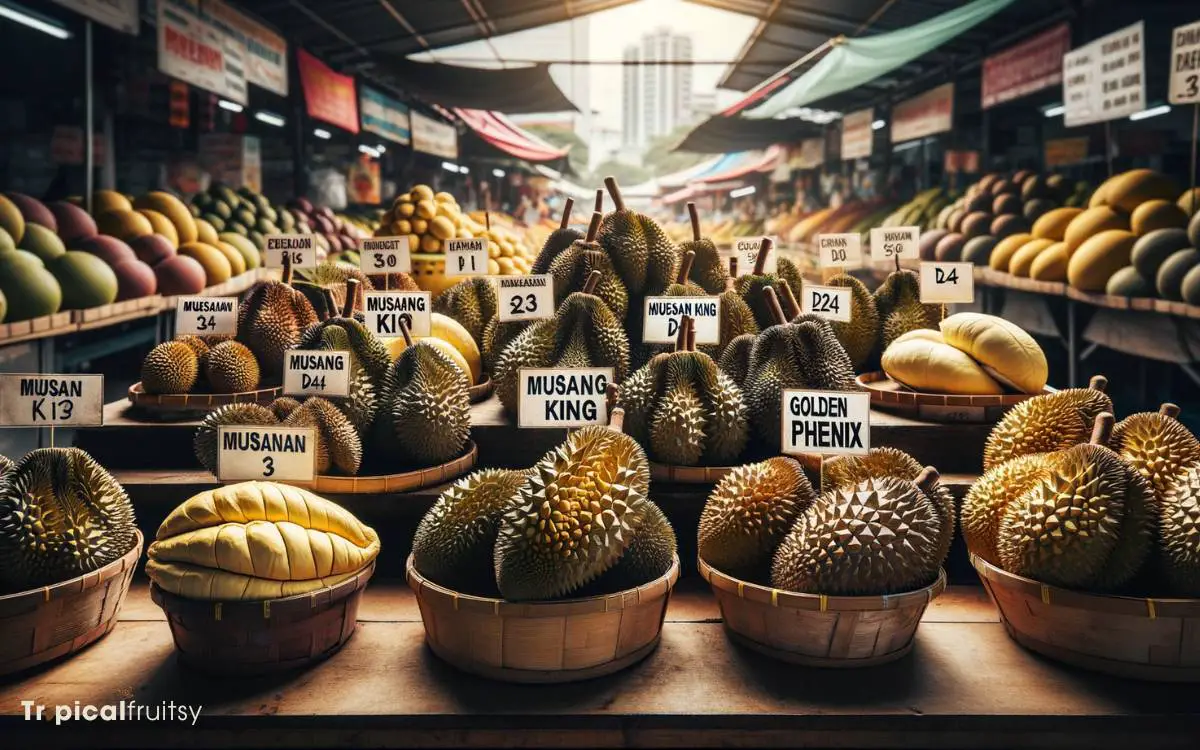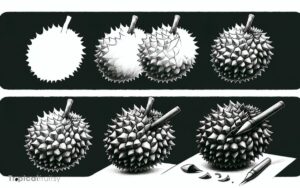How to Eat Durian Without Smell? 7 Easy Steps!
To enjoy durian without being overwhelmed by its smell, choose milder varieties, utilize proper storage methods, consume it quickly, or mask the odor with other scents.
Durian’s notorious smell can be managed by:
Savor the taste of durian without the strong smell by choosing the right variety and using effective odor management techniques.

Key Takeaway
Effective Strategies to Enjoy Durian with Minimal Smell
| Strategy | Description | Examples |
|---|---|---|
| Choose Milder Varieties | Opt for durian types with a subtler scent. | Musang King, D24 |
| Proper Storage | Store durian in ways that limit the spread of its aroma. | Airtight containers, Refrigeration |
| Quick Consumption | Eat the durian promptly after opening it. | – |
| Odor Masking | Use other scents to cover up the durian smell. | Coffee beans, Lemon slices |
Understanding Durian’s Aroma

The pungent odor of durian, often likened to a blend of sweet fruitiness and sulfurous undertones, is a result of its unique composition of volatile sulfur compounds.
These biochemical constituents, including ethanethiol and other thiols, as well as sulfides and disulfides, are responsible for the fruit’s penetrating scent.
Scientific analysis reveals that the particular combination and concentration of these compounds give durian its distinctive aroma, which can be overpowering to the unaccustomed olfactory system.
Enzymatic reactions within the fruit upon ripening lead to the release of these volatile elements, further intensifying its smell.
Understanding the chemical basis of durian’s odor provides insight into its divisive reception among individuals.
This knowledge is crucial when moving forward to selecting the right variety, which may offer a milder olfactory experience.
Step 1: Choosing the Right Variety

Selecting a durian variety with a milder scent is essential for those seeking to enjoy the fruit’s flavor without the overpowering smell.
Not all durians emit the same level of aroma; the intensity and character of the scent can vary significantly across different species and cultivars.
Analytically, one should consider the genetic lineage, as some cultivars, like the Thai ‘Chanee’ or ‘Monthong’, are known for their comparatively subdued olfactory footprint.
These varieties have been selectively bred for a more palatable aroma profile, which makes them suitable for individuals with olfactory sensitivity.
It is imperative to conduct a sensory evaluation before purchase, noting the subtle differences in scent among available options.
This precise selection process leads seamlessly to the subsequent consideration: optimal storage techniques to further mitigate the durian’s pungent aroma.
Step 2: Optimal Storage Techniques

To mitigate the pungent aroma of durian, employing airtight containers is essential for creating an odor barrier.
Temperature control is a critical factor; storing durian at a low temperature reduces the volatility of odoriferous compounds.
These storage strategies, when applied correctly, have a significant impact on the containment of durian’s smell, ensuring a more pleasant environment for consumers and handlers alike.
Airtight Containers
Utilizing airtight containers is an effective method to contain the pungent aroma of durian and preserve its freshness for consumption.
These containers should exhibit high impermeability to volatile organic compounds to mitigate odor dispersion. Materials such as glass or high-density polyethylene offer suitable barriers and should be selected to ensure olfactory containment.
Furthermore, the integrity of the seal is paramount; silicone gaskets or similar sealing mechanisms enhance the efficacy of the container.
When storing durian, it is crucial to expel as much air as possible before sealing to minimize oxidation and aroma leakage.
The technical specification of the container must also consider the durian’s size and the desired duration of storage.
Temperature Control
Maintaining durian at a temperature between 45°F and 54°F (7°C and 12°C) effectively reduces the dissemination of its strong scent while preserving its quality for consumption.
This temperature range slows the metabolic processes that contribute to the emission of volatile sulfur compounds responsible for the fruit’s pungent odor. Precise temperature control within refrigeration units is paramount for mitigating olfactory impact.
| Temperature Range | Effectiveness |
|---|---|
| Below 45°F (7°C) | Overly suppresses ripening; may affect texture and taste negatively |
| 45°F – 54°F (7°C – 12°C) | Optimal for reducing odor while maintaining quality |
| Above 54°F (12°C) | Accelerates ripening; increases scent dissemination |
| Room Temperature | Not recommended for odor control |
Refrigeration at these specific parameters not only curtails aroma broadcast but also extends the shelf life.
Step 3: Preparing Durian Outdoors

Set up your durian-eating station outside to significantly reduce the pungent aroma’s infiltration of indoor spaces. Select an open-air environment with sufficient ventilation to disperse the fruit’s potent smell.
Ensure the surface is stable and clean, preferably a dedicated table that can be easily deodorized post-consumption.
Utilize disposable gloves and utensils to minimize direct contact, as the fruit’s residue can transfer the odor to skin and objects.
It is advisable to prepare a containment strategy for the discarded shells and seeds, such as sealable bags, to confine the smell immediately after consumption.
This outdoor methodology allows for an olfactory buffer zone, mitigating the impact on enclosed living areas.
Step 4: Utilizing Freezing Methods

Freezing the durian before consumption can effectively diminish its strong odor, providing a practical solution for those seeking to enjoy the fruit with minimal olfactory discomfort.
This method leverages the reduced volatility of odoriferous compounds at lower temperatures, thus mitigating the emission of the characteristic durian smell.
The process involves sealing the durian in airtight containers or wrap to prevent the aroma from permeating the freezer.
Once thawed, the durian’s scent is significantly less pungent, making it more palatable for sensitive individuals.
| Emotion Elicited | Description |
|---|---|
| Relief | Subdued durian aroma |
| Satisfaction | Pleasant eating experience |
| Anticipation | Enjoyment without the strong smell |
| Curiosity | Interest in the altered texture |
| Contentment | Minimal olfactory impact |
Step 5: Masking the Scent

Approaching the issue of durian odor, the application of odor-neutralizing products offers a chemical counteraction to the fruit’s pungent molecules.
Consumption in open-air environments can significantly dissipate the concentration of odorants, reducing olfactory detection.
Meanwhile, the use of airtight storage methods provides a physical barrier, containing the volatile compounds responsible for the durian’s distinctive scent.
Odor-Neutralizing Products
Several odor-neutralizing products can effectively mask the pungent scent of durian, allowing for a more pleasant eating experience.
These products contain compounds that either absorb odoriferous molecules or chemically neutralize them to mitigate the characteristic aroma.
The application of these products is critical; they should be used in accordance with their specific instructions to ensure maximum efficacy.
A systematic approach to odor management, particularly with volatiles as potent as those released by durian, is essential for satisfactory results.
| Product Type | Mechanism of Action |
|---|---|
| Activated Charcoal | Adsorbs odor-causing particles from the air. |
| Odor-Absorbing Gel | Contains a complex matrix that traps malodorous compounds. |
| Neutralizing Spray | Chemically transforms odor molecules into non-odorous substances. |
These solutions provide various options for consumers to engage with durian fruit without the inconvenience of its strong odor.
Outdoor Consumption
One effective method to minimize the potent smell of durian while consuming it outdoors is to create a barrier between the fruit and the surrounding air.
Strategically, the application of physical containment systems, such as airtight containers or specially designed durian husk carriers, can significantly reduce the diffusion of odor molecules.
When selecting a containment method, it is crucial to consider material properties such as permeability and seal integrity.
A high-density, impermeable material ensures that the volatile sulfur compounds, primarily responsible for the fruit’s pungent aroma, are contained within the enclosure.
Furthermore, immediate consumption after opening and prompt resealing minimize the duration and intensity of odor exposure, thereby mitigating olfactory impact on the immediate environment and bystanders.
Airtight Storage Methods
Transitioning from outdoor consumption strategies, the second approach involves utilizing airtight storage methods to effectively mask the durian’s pungent scent.
When considering containment options for durian, it is critical to prioritize the integrity of the seal to prevent volatile organic compounds responsible for the odor from escaping.
Here are key airtight storage solutions:
- Vacuum Sealing: Utilize a vacuum sealer to encase the durian in plastic, removing air and sealing the fruit’s aroma within.
- Silicone Containers: Opt for heavy-duty silicone containers that offer an impermeable barrier against odor transmission.
- Glass Jars with Rubber Gaskets: Employ glass jars with rubber gaskets and locking mechanisms to establish a hermetic seal, thereby inhibiting the diffusion of smell.
These methods are instrumental in maintaining an odor-neutral environment while preserving the durian’s taste and freshness.
Step 6: Speedy Consumption Practices

To minimize the durian’s pungent odor during consumption, it is essential to employ efficient eating techniques that allow for swift ingestion.
Rapid consumption reduces the duration of odor exposure and limits the volatile compounds released into the air.
| Step | Description | Benefit |
|---|---|---|
| Pre-Segmentation | Pre-cut durian into consumable segments to expedite eating. | Decreases handling time, lessening odor dispersion. |
| Utensil Use | Utilize forks or specialized durian tools to quickly transfer to the mouth. | Minimizes direct contact, reducing smell on hands. |
| Concurrent Ventilation | Eat in a well-ventilated area to dissipate odors swiftly. | Facilitates rapid odor dissipation from the environment. |
Adherence to these methods ensures the olfactory impact is managed effectively, maintaining a more pleasant consumption experience.
Step 7: Post-Enjoyment Cleanup

After savoring the durian, it is crucial to implement thorough cleaning procedures to eliminate any residual odor.
The following list delineates a tripartite approach designed for effective olfactory decontamination:
- Surface Deodorization: Clean all surfaces that came into contact with durian using a blend of bicarbonate of soda and water, which acts as a neutralizing agent, to chemically absorb and nullify the scent molecules.
- Aerial Purification: Deploy an air purifier equipped with an activated carbon filter capable of adsorbing the volatile organic compounds responsible for the durian’s pungent aroma.
- Material Treatment: Launder any fabric that may have been exposed to the fruit’s essence utilizing enzymatic detergents specifically formulated to breakdown complex organic odorants.
How to Pack Durian Without Smell

Packing durian without the strong smell can be a challenging task due to the fruit’s potent aroma. However, there are some steps you can take to minimize the odor and keep it contained.
Here’s how to pack durian without the smell:
- Choose the Right Container: Use an airtight and odor-resistant container for storing durian. Containers with strong sealing capabilities will help trap the smell inside.
- Double Bagging: Place the durian in a plastic bag, and then put this bag into a second plastic bag. Make sure both bags are sealed tightly to prevent any odor from escaping.
- Use a Sealed Container: Opt for a container with a secure lid or cover. Tupperware-style containers with airtight seals are effective at containing odors.
- Wrap with Plastic Wrap: Wrap the durian in several layers of plastic wrap before placing it inside the container. This additional layer can help contain the odor.
- Seal with Tape: Use strong tape, such as duct tape or packaging tape, to seal the edges of the container or plastic bags further. This will add an extra layer of protection against odors escaping.
- Isolate the Durian: Place the container in a separate bag or box to further isolate the durian. This will provide an extra barrier to prevent the smell from permeating other items.
- Store in a Cooler or Fridge: If possible, store the packed durian in a cooler or refrigerator. The cold temperature can help reduce the volatility of the odor.
- Keep It Frozen: Freezing durian can help minimize its smell. Store it in an airtight container or vacuum-sealed bag in the freezer until you’re ready to consume it.
- Choose a Less Pungent Variety: Some durian varieties are less pungent and have a milder odor. If available, consider selecting these varieties to reduce the overall smell.
- Handle with Care: When packing and unpacking the durian, be cautious not to puncture the bags or containers, as this can release the smell.
- Dispose of Packaging Properly: After consuming the durian, dispose of the bags, containers, and any wrapping materials properly to prevent lingering odors.
- Ventilation: If you’re transporting durian in a vehicle, ensure good ventilation by opening windows or using the vehicle’s ventilation system to circulate air. This can help dissipate the odor.
Keep in mind that despite your best efforts, some odor may still escape when dealing with durian. It’s a notoriously pungent fruit, and the aroma can be challenging to completely contain.
However, following these steps should help minimize the smell and make the experience more manageable when transporting or storing durian.
Conclusion
The effective management of durian’s pervasive aroma can enhance the consumption experience for both aficionados and novices.
By selecting appropriate varieties, employing strategic storage and preparation methods, and implementing scent-masking techniques, individuals can mitigate the fruit’s olfactory impact.
Although some purists may argue that the scent is integral to the experience, these strategies allow for a more inclusive appreciation of durian’s unique flavor profile, broadening its culinary appeal.






